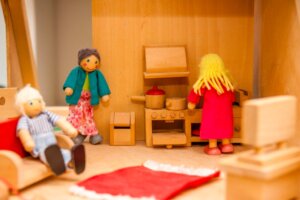Doll Therapy


Written and verified by the psychologist Sofía Gimbert
Doll therapy is a creative form of treatment that uses dolls and other objects to represent situations, emotions, and relationships. It’s a non-verbal method, which allows people to show themselves in a natural and genuine way, through elements that symbolize what they think and feel.
During the sessions, the therapist provides dolls and other objects. The patient chooses them according to what they want to express. The purpose is to explore and work on different aspects of their life, from interpersonal relationships to internal emotions.
These therapies are beneficial for those who have difficulties expressing their emotions verbally or find it challenging to identify what’s wrong with them. In effect, it gives them a tool for non-verbal expression.
Benefits of doll therapy
Doll therapy offers many emotional and psychological benefits. For example:
- Disclosure of Emotions. Treatment encourages the expression of emotions in a natural way. This can help reduce anxiety, stress, and depression.
- It intervenes in the resolution of internal conflicts. The sessions help the patient to understand and resolve internal conflicts and integrate the different areas of their personality.
- Development of creativity. Doll therapy is a creative way of investigating and working on different aspects of the patient’s life. It’s useful for developing their creativity and imagination.
- Strengthening interpersonal relationships. By representing situations and relationships with dolls, patients improve their ability to communicate and solve problems in their interpersonal relationships.

Doll therapy and its relationship with systemic therapy
Doll therapy goes together well with systemic therapy. That’s because this therapy centers on people, relationships, and the systems in which they interact. In fact, it employs the metaphor of the family to describe the relationships between individuals and their environment.
In doll therapy, resources such as dolls and other objects constitute the different aspects of the personality. Patients explore and work with these aspects individually. For example, they can use one doll to symbolize their partner and another to represent their boss.
By using these techniques to address specific situations, the patient investigates and works on their relationships and situations that affect their emotional and psychological well-being.
The link between both therapies is also evident in the methods they use in order to help the patient communicate and solve problems.
For example, if a couple is having difficulty communicating, they can implement the dolls to interpret the situation and explore different ways of speaking effectively.
Doll therapy and their relationship with the internal world
On the other hand, doll therapy is also well suited to the Internal Family Systems (IFS) therapeutic approach. This therapy is based on the relationship between the different aspects of the personality. It also uses the metaphor of the family.
For instance, the patient uses one doll to portray their anxious part and another to represent their trusting part. This makes the therapy easier.
“Dolls and other figures can be used in therapy to represent parts of oneself that may be difficult to face directly, helping people develop a greater understanding and acceptance of themselves.”
-Sue Jennings-
There’s also a link between doll therapy and the IFS approach because they’re both applied to help resolve internal conflicts. Let’s look at another example.
A patient can use dolls that represent the parts of their personality in conflict. Therefore, they can explore and work with their internal conflicts in a safe way. In fact, integrating the different aspects of the personality is a key process. It helps the patient feel more complete and coherent.

Conclusions and reflections on doll therapy
Doll therapy is a creative and effective way of exploring the internal world of the individual. The method relates particularly well to psychology and the IFS approach.
Moreover, this therapy promotes communication and solves problems in interpersonal relationships. It also helps patients to integrate aspects of their personalities.
If you’re interested in this technique, we suggest you find a therapist who’s experienced in it. However, you must be willing to delve into and work through your feelings and thoughts in an open and honest way.
As a rule, this is a unique and effective mode of therapy. In effect, by providing a non-verbal and creative mechanism to express feelings and thoughts, the sessions help patients improve their emotional and psychological well-being.
Doll therapy is a creative form of treatment that uses dolls and other objects to represent situations, emotions, and relationships. It’s a non-verbal method, which allows people to show themselves in a natural and genuine way, through elements that symbolize what they think and feel.
During the sessions, the therapist provides dolls and other objects. The patient chooses them according to what they want to express. The purpose is to explore and work on different aspects of their life, from interpersonal relationships to internal emotions.
These therapies are beneficial for those who have difficulties expressing their emotions verbally or find it challenging to identify what’s wrong with them. In effect, it gives them a tool for non-verbal expression.
Benefits of doll therapy
Doll therapy offers many emotional and psychological benefits. For example:
- Disclosure of Emotions. Treatment encourages the expression of emotions in a natural way. This can help reduce anxiety, stress, and depression.
- It intervenes in the resolution of internal conflicts. The sessions help the patient to understand and resolve internal conflicts and integrate the different areas of their personality.
- Development of creativity. Doll therapy is a creative way of investigating and working on different aspects of the patient’s life. It’s useful for developing their creativity and imagination.
- Strengthening interpersonal relationships. By representing situations and relationships with dolls, patients improve their ability to communicate and solve problems in their interpersonal relationships.

Doll therapy and its relationship with systemic therapy
Doll therapy goes together well with systemic therapy. That’s because this therapy centers on people, relationships, and the systems in which they interact. In fact, it employs the metaphor of the family to describe the relationships between individuals and their environment.
In doll therapy, resources such as dolls and other objects constitute the different aspects of the personality. Patients explore and work with these aspects individually. For example, they can use one doll to symbolize their partner and another to represent their boss.
By using these techniques to address specific situations, the patient investigates and works on their relationships and situations that affect their emotional and psychological well-being.
The link between both therapies is also evident in the methods they use in order to help the patient communicate and solve problems.
For example, if a couple is having difficulty communicating, they can implement the dolls to interpret the situation and explore different ways of speaking effectively.
Doll therapy and their relationship with the internal world
On the other hand, doll therapy is also well suited to the Internal Family Systems (IFS) therapeutic approach. This therapy is based on the relationship between the different aspects of the personality. It also uses the metaphor of the family.
For instance, the patient uses one doll to portray their anxious part and another to represent their trusting part. This makes the therapy easier.
“Dolls and other figures can be used in therapy to represent parts of oneself that may be difficult to face directly, helping people develop a greater understanding and acceptance of themselves.”
-Sue Jennings-
There’s also a link between doll therapy and the IFS approach because they’re both applied to help resolve internal conflicts. Let’s look at another example.
A patient can use dolls that represent the parts of their personality in conflict. Therefore, they can explore and work with their internal conflicts in a safe way. In fact, integrating the different aspects of the personality is a key process. It helps the patient feel more complete and coherent.

Conclusions and reflections on doll therapy
Doll therapy is a creative and effective way of exploring the internal world of the individual. The method relates particularly well to psychology and the IFS approach.
Moreover, this therapy promotes communication and solves problems in interpersonal relationships. It also helps patients to integrate aspects of their personalities.
If you’re interested in this technique, we suggest you find a therapist who’s experienced in it. However, you must be willing to delve into and work through your feelings and thoughts in an open and honest way.
As a rule, this is a unique and effective mode of therapy. In effect, by providing a non-verbal and creative mechanism to express feelings and thoughts, the sessions help patients improve their emotional and psychological well-being.
All cited sources were thoroughly reviewed by our team to ensure their quality, reliability, currency, and validity. The bibliography of this article was considered reliable and of academic or scientific accuracy.
- Ray, D. C., Lee, K. R., Meany-Walen, K. K., Carlson, S. E., Carnes-Holt, K. L., & Ware, J. N. (2013). Use of toys in child-centered play therapy. International Journal of Play Therapy, 22(1), 43–57. https://doi.org/10.1037/a0031430
- IFS Institute. https://ifs-institute.com/
- Schwartz, R. C., & Sweezy, M. (2019). Internal family systems therapy. Guilford Publications.
- Stiles, W. B., Barkham, M., Connell, J., & Mellor-Clark, J. (2008). Responsive regulation of treatment duration in routine practice in United Kingdom primary care settings: replication in a larger sample. Journal of Consulting and Clinical Psychology, 76(2), 298. https://pubmed.ncbi.nlm.nih.gov/18377125/
- PlayTerapia. (s.f.). ¿Qué es la terapia con muñecos? PlayTerapia.
This text is provided for informational purposes only and does not replace consultation with a professional. If in doubt, consult your specialist.







